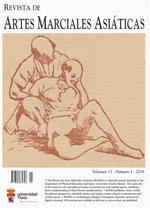Kata – A verdadeira essência das artes marciais Budô?
DOI:
https://doi.org/10.18002/rama.v11i1.3693Palavras-chave:
kata, budô, artes marciais, bushido, espiritualidade, pedagogiaResumo
Este trabalho utiliza a técnica de investigação documental para analisar o uso das kata, ou formas, nas artes marciais japonesas. Depois de uma introdução sobre a existência da prática das katas, utilizando fontes de informação disponíveis, examina-se, em primeiro lugar, os desenvolvimentos espirituais do bushido. Em segundo lugar, analisam-se as interações sociais que levaram à transformação do bujutsu em budô. No desenvolvimento, explora-se a posição das katas em relação às artes marciais budô, seguindo-se uma discussão sobre o uso das katas como pedagogia. Por último, analisam-se as katas a partir do contexto investigado, demonstrando como as katas poderão representar a pretendida essência do budô, assim como uma pedagogia espiritual culturalmente valiosa.Downloads
Métricas alternativas
Referências
Bolelli, D. (2008). On the Warrior’s Path. Berkeley, California: Blue Snake Books.
Bourdieu, P. (1977). Outline of a theory of practice. Translated by Nice, R. 1977. Cambridge: Cambridge University Press.
Brown, D. (in press) Taoism through Tai Chi Chuan: Physical Culture as Religious or holistic spirituality? In M. de Souza, J. Bone, & J. Watson (eds.), Spirituality across Disciplines: Research and Practice in Education, Health and Social Care, Theology, Business, Sustainability and Cultural Studies. London: Springer.
Brown, D., Jennings, G., & Molle, A. (2009). Exploring relationships between Asian martial arts and religion. Stadion: International Journal of the History of Sport, 35, 47-66.
Brown, D., & Leledaki, A. (2010). Eastern Movement Forms as Body-Self Transforming Cultural Practices in the West: Towards a Sociological Perspective. Cultural Sociology, 4(1), 123-154.
Clarke, J. (1997). Oriental Enlightenment: The Encounter Between Asian and Western Thought. London: Routledge.
Deshimaru, T. (1982). The Zen Way to the Martial Arts. New York: Penguin Group.
Forman, J., & Damschroder, L. (2008). Qualitative Content Analysis. Empirical Methods of Bioethics: A Primer, 11, 39-62.
Funakoshi, G. (1938). The Twenty Guiding Principles of Karate: The Spiritual Legacy of the Master. Translated by John Teramoto, 2003. New York, London, Tokyo: Kodansha International.
Funakoshi, G. (1973). Karate-do Kyohan. Tokyo, New York, San Francisco: Kodansha International.
Funakoshi, G. (1975). Karate-do: My Way of Life. Tokyo, New York, San Francisco: Kodansha International.
Funakoshi, G. (1988). Karate-do Nyumon. Tokyo, New York, San Francisco: Kodansha International
Giddens, A. (2009). Sociology. Cambridge: Polity Press.
Glaser, B., & Strauss, A. (1967). The Discovery of Grounded Theory: Strategies for Qualitative Research. Chicago: Aldine.
Gluck, C. (1985). Japan’s Modern Myths: Ideology in the Late Meiji Period. Princeton, New Jersey: Princeton University Press.
Green, T., & Svinth, J. (eds.) (2010). Martial Arts of the World: An Encyclopedia of History and Innovation. Santa Barbara, California: ABC-CLIO.
Guttmann, A., & Thompson, L. (2001). Japanese Sports: a History. Honolulu: University of Hawai’i Press.
Hare, T. (1998). Try, try again: Training in noh drama. In T. P. Rohlen & G. K. LeTendre (eds.), Teaching and Learning in Japan (pp. 323-344). New York: Cambridge University Press.
Hyams, J. (1979). Zen in the Martial Arts. New York: Jeremy P. Tarcher/Putnam.
Japan Karate Association, (2016). The Five Dojo Kun. Retrieved from http://jka.or.jp/en/karate/philosophy.html
Kamata, S., & Shimazu, K. (1992). Zen and Aikido. Tokyo: Aiki News.
Kanno, K. (2009). From Bushido to Budo. In A. Bennett (ed.), Budo. The Martial Ways of Japan (pp. 66-70). Tokyo: Nippon Budokan.
Kano, J. (1986). Kodokan Judo. Tokyo: Kodansha International.
Keister, J. (2008). Okeikoba: Lesson places as sites for negotiating tradition in Japanese music. Ethnomusicology, 52(2). 239–69.
Kohn, T. (2001). ‘Don’t Talk – Blend’: Ideas about body and communication in aikido practice. In J. Hendry & C. W. Watson (eds.), An Anthropology of Indirect Communication (pp. 163-178). London: Routledge.
Kohn, T. (2003). The Aikido Body: Expressions of Group Identities and Self Discovery in Martial Arts Training. In N. Dyck & E. P. Archetti (eds.), Sport, Dance and Embodied Identites (pp. 139-155). Oxford: Berg.
Kohn, T. (2007). Bowing onto the Mat: Discourses of Change Through Martial Practice. In S. Coleman & T. Kohn (eds.), The Discipline of Leisure: Embodying Cultures of ‘Recreation’ (pp. 171-186). Oxford: Berghahn Books.
Kohn, T. (2008). Creatively Scuplting the Self through the Discipline of Martial Arts Training. In N. Dyck (ed.), Exploring Regimes of Discipline: The Dynamics of Restraint (pp. 99-112). Oxford: Berghahn Books.
Kuckartz, U. (2014). Qualitative Text Analysis: A Guide to Methods, Practice & Using Software. London: Sage Publications, Ltd.
Matsunobu, K. (2007). Spiritual Arts and the Education of “Less is more”: Japanese Perspectives, Western Possibilities. Journal of the Canadian Association for Curriculum Studies, 5(1), 103-119.
Matsunobu, K. (2011). Creativity of formulaic learning: Pedagogy of imitation and repetition. In J. Sefton-Green, P. Thomson, K. Jones, & L. Bresler (Eds.), International Handbook of Creative Learning (pp. 45-53). Abingdon: Routledge.
Matsunobu, K. (in press). Conforming the Body, Cultivating Individuality: Intercultural Understandings of Japanese Noh. In K. Powell, P. Burnhard, & L. Mackinlay (Eds.), International Handbook of Intercultural Arts Research. Abingdon: Routledge.
Matthews, W. (2012). World Religions (7th ed.). Belmont, CA: Wadsworth, Cengage Learning
Molle, A. 2010. Towards a Sociology of budo: Studying the Implicit Religious Issues. Implicit Religion, 13, 85- 104.
Nagatomo, S. (2015). A Sketch of the Diamond Sutra’s Logic of Not. In D. Jones & E. R. Klein (Eds.), Asian Texts – Asian Contexts: Encounters with Asian Philosophies and Religions (pp. 197-210). Albany, New York: State University of New York Press.
Nitobe, I. (1908). Bushido: the Soul of Japan. Tokyo: Teibi Publishing Company.
Noguchi, H. (2004). The Idea of the Body in Japanese Culture and its Dismantlement. International Journal of Sport and Health Science, 2, 8-24.
Rafolt, L. (2014). Ritual Formalism and the Intangible Body of the Japanese Koryū Budō Culture. Narodna umjetnost: Croatian Journal of Ethnology and Folklore Research, 51(1), 183-208.
Rohlen, T., & LeTendre, G. (1996/1998). Conclusion: themes in the Japanese culture of learning. In T. P. Rohlen & G. K. LeTendre (eds.), Teaching and Learning in Japan (pp. 369-376). New York: Cambridge University Press.
Rudowicz, E. (2004) Creativity among Chinese people: beyond western perspective. In S. Lau, A. H. H. Hui, & G. Y. C. Ng (eds.) Creativity: When East Meets West (pp. 55-86). River Edge, NJ: World Scientific Publishing.
Said, E. (1977). Orientalism. London: Penguin.
Sasaki, T. (2008). Budo (the martial arts) as Japanese culture. The outlook on the techniques and the outlook on the human being. Archives of Budo, 4, 46-49.
Schippers, H. (2010). Facing the music: Shaping music education from a global perspective. New York, NY: Oxford University Press.
Shi-Xu (2001). Critical Pedagogy and Intercultural Communication: Creating discourses of diversity, equality, common goals and rational-moral motivation. Journal of Intercultural Studies, 22(3), 279-293.
Shun, I. (2001). The Invention of the Martial Arts: Kano Jigoro and Kodokan. In S. Vlastos (ed.), Mirror of Modernity: Invented Traditions of Modern Japan (pp. 163-173). Berkely, CA: University of California Press.
Stevens, J. (2007). Zen Bow, Zen Arrow: the Life and Teachings of Awa Kenzo, the Archery Master from Zen in the Art of Archery. Boston, Massachusetts: Shambhala Publications.
Strauss, A., & Corbin, J. (1998). Basics of Qualitative Research: Techniques and Procedures for Developing Grounded Theory (2nd ed.). Thousand Oaks, CA: Sage Publications.
Sugie, M. (2009). Japanese Budo. In A. Bennett (ed.), Budo. The Martial Ways of Japan (pp. 27-34). Tokyo: Nippon Budokan.
Trimble, A., & Morris, V. (1995). Karate Kata applications. London: Ebury Press.
Trimillos, R. (1989). Halau, Hochschule, Maystro, and Ryu: Cultural approaches to music learning and teaching. International Journal of Music Education, 14, 32-43.
Tsunetomo, Y. (1979). Hagakure: the Book of the Samurai. W. S. Wilson (trans.). Tokyo: Kodansha International.
Ueshiba, M. (2013). Budo: Teachings of the Founder of Aikido. New York: Kodansha USA.
Wilson, W. (2010). Essays on the Martial Arts: The Meaning of Bu and Budo. Retrieved from http://www.mineralogicalrecord.com/wilson/pdfs/Concepts--Bu%20and%20Budo.pdf
Yano, C. (2002). Tears of Longing: Nostalgia and the Nation in Japanese Popular song. Cambridge, MA: Harvard University Asia Centre.
Yokota, K. (2010). Shotokan Myths: The Forbidden Answers to the Mysteries of Shotokan Karate. USA: Xlibris.
Downloads
Publicado
Como Citar
Edição
Secção
Licença
Direitos de Autor (c) 2016 Simon Alexander Dodd, David Brown

Este trabalho encontra-se publicado com a Licença Internacional Creative Commons Atribuição-NãoComercial-CompartilhaIgual 4.0.
Os autores que publicam nesta Revista estão de acordo com os seguintes termos:
- Os autores cedem, de forma exclusiva, os direitos de exploração (reprodução, distribuição, comunicação pública, transformação) à Universidade de Léon, podendo estabelecer, em separado, acordos adicionais para a distribuição não exclusiva da versão do artigo publicado na Revista (por exemplo: alojar no repertório institucional ou publicá-lo num livro), com o reconhecimento da publicação inicial nesta Revista.
- O trabalho encontra-se na Creative Commons Attribution-Non Commercial-Share Alike 4.0 International License. Pode-se consultar aqui o resumo e o texto legal da licença.
- Permite-se, e sugere-se, que os autores difundam electronicamente as versões pré-impressão (versão antes de ser avaliada) e pós-impressão (versão avaliada e aceite para publicação das suas obras antes da sua publicação), favorecendo a sua circulação e difusão, e com ela o possível aumento da sua citação e alcance pela comunidade académica.











